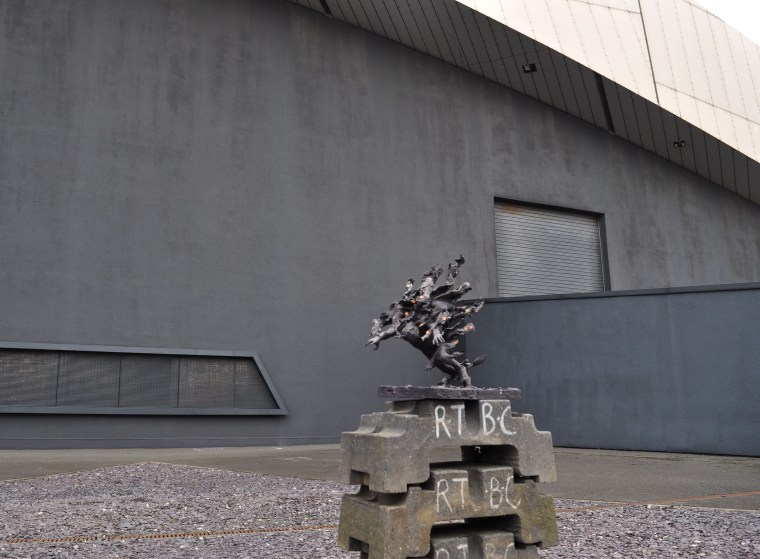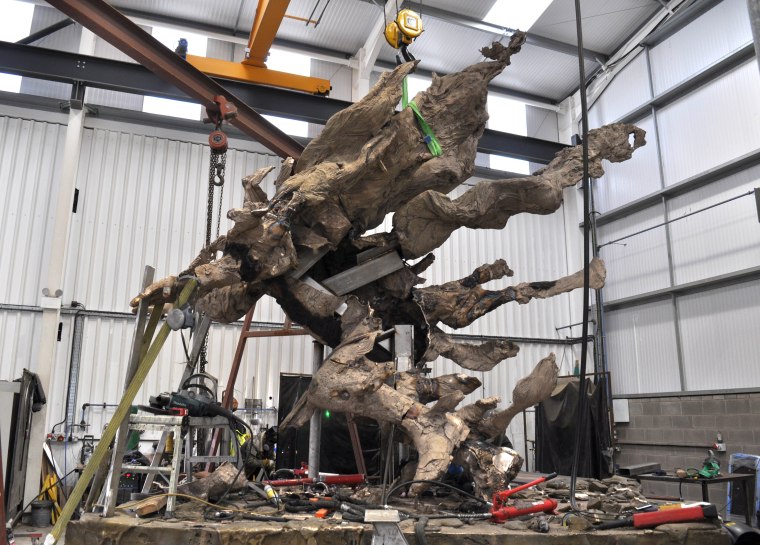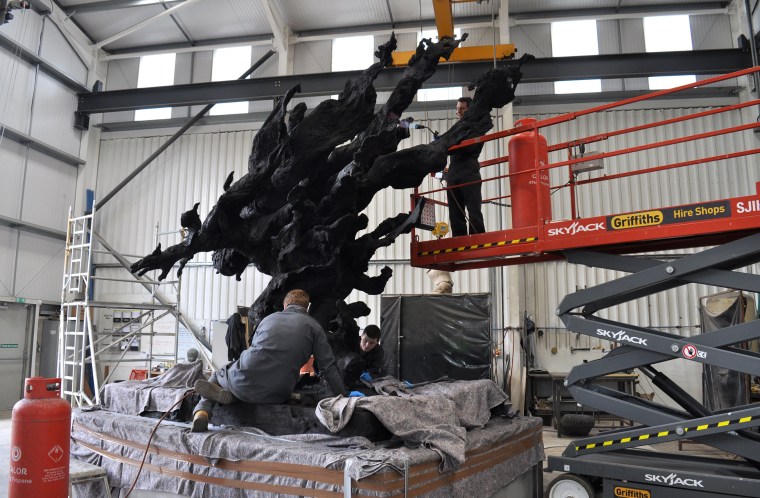
Alone he stands, for the world to see. One man’s intense sculptural statement on the horror of war.
A moment of another man’s suffering forever captured now in bronze and permanently displayed outside the Imperial War Museum in Manchester. A story of the courage and bravery. Hero and victim.
In Tim’s words…
‘Although Man on Fire is shaped by the well known images of soldiers diving from the armoured vehicle -it’s important to note the work itself represents not just those caught in the theatre of war- it’s about everyman, woman and child caught between warring factions.”
The work itself is courageous act of commitment to something monumental, without the security of knowing where it will go… the bravery to keep going.
Now the time has come.
It’s been three years since visiting Tim at his studio in the Cornish countryside. We stepped out of the sunshine on that bright, late summers day and entered another world.

Inside the darkened atmospheric space of the farm building stood the full-size sculpture. The temporary home of “Man on Fire”. In that moment I knew we were about to embark on something powerful. A work to challenge our skills and stretch our capabilities. A task to grow by and measure our future selves against.
The sculpture is a dynamic flowing form that, at first glance, is hard to take in. A figure larger than life is falling forward on one leg, arms outstretched, engulfed in flames that fly out and up. The surface of recycled black plastic, twisted and creased with the texture of burnt wood. I’d seen pictures but the reality of the confrontation was a shock. It screamed pain.
We walked around the work in silence, taking it in and gathering my thoughts. The scale. The complexity. The energy.
Our part in the story is to capture this in bronze. To encapsulate. To create permanence. Through a process of deconstruction and reconstruction, turn expanded foam and plastic bags into a lasting legacy that can face the world. In the subdued light of the barn I imagine the bronze and feel the challenge. Keeping any doubts and insecurities to myself the conversation quickly turned to practical things and the job in hand. How will it be transported? Will it stand up in bronze?
We will find a way…it’s what we do.
Tim has been working on Man on Fire for a long time. Returning to it, refining it. Now the moment has finally come to cast it. A few months later the work arrives in sections at our Liverpool workshop and we set it up with Tim.
A new setting.

Before moulding the whole work is scanned, allowing for a highly detailed scale model to be 3D printed. This data is our reference for later, when we reconstruct the casting sections. The model will aid the structural engineer in his calculations for loadings. It also allows Tim to produce an edition of bronze maquettes, with all the detail and form of the hand built monumental sculpture captured and presented through the magic of technology.
Meanwhile we live with the work and contemplate the complications of the moulding process that lie ahead.
The surface of plastic bags is loose, delicate and in places almost inaccessible. Sections can be removed but the plan is to maintain the position of the figure’s stance by moulding upright. Our recent investment in a silicone rubber spray machine proved invaluable, capturing the integrity of every detail without disturbance to the surface.

Moulds are fed into the foundry as sections are finished and casting is underway. Pieces of the puzzle are everywhere, at different stages. Each wax section is checked by Tim and details added. The bronze base is cast and finished first and sits waiting to carry its load.



There are discussions and decisions to be made. Zoom meetings with the museum. Dates to be decided. The plinth has to be designed and the precise position and height agreed. In the end a stainless steel fabrication is chosen, reflecting the material finish of the museum striking modern architecture.


The complex and critical internal structure had to be engineered. The limitations of the tightly angled ankle and available space inside the leg meant that the standard bent bar wasn’t going to work without infringing on the integrity of the design. The figure had to be almost in motion, flying. Heavy stainless steel plates were laser cut from templates, laminated and fully welded to form a perfectly fitting internal structure. Flame sections were internally reinforced. Hidden fixings, crafted but never seen, holding up two tons of flying bronze.

All the action revolves around the figure as the reconstruction happens, as each new cast and finished section is positioned, tweaked and welded solid. Crane, scaffolding and scissor-lift surround the growing work, juggling for position and access as the flame sections are fitted into the tight spaces. The seams are blended and crafted to disappear as textures are cut and ground into bronze.



Flames from the blow torches hit the surface, bouncing over and around the work and steam rises as the jet black patina is applied. The last traces of the fabrication process are erased as the colour pulls together the completed work, activating the details of the crinkled “burnt” surface that tell their own story.



Tim’s watchful eye oversees every stage with enthusiasm, precision and dedication. Part of the team and the team responded, as always, with dedication of their own. This work is made with love.
All the time, the now battered but still standing original foam of the man stands outside the metalwork shop, surviving. For reference, yes, but also as a symbol. Its presence a reminder of the journey, the process. A reference to the intensity of “Man of Fire”… and Tim wants to keep it.



Structural Engineer: Ozgur Keskin
Transport: J A MacKenzie Limited
Scanning and 3D Printing of maquette: Europac 3D





















I feel so very privileged to have received this superb report. Tim Shaw is a truly wonderful artist . His sculpture is horrific, immensely powerful yet full of humanity.
The complex technology of the process to covert it to bronze is jaw-dropping and totally fascinating. I once spent a day at Castle Fine Arts Foundry and will never forget it.
For me this work stands alongside the most moving war poetry that I love so much.
A humble thank you to all involved.
LikeLike